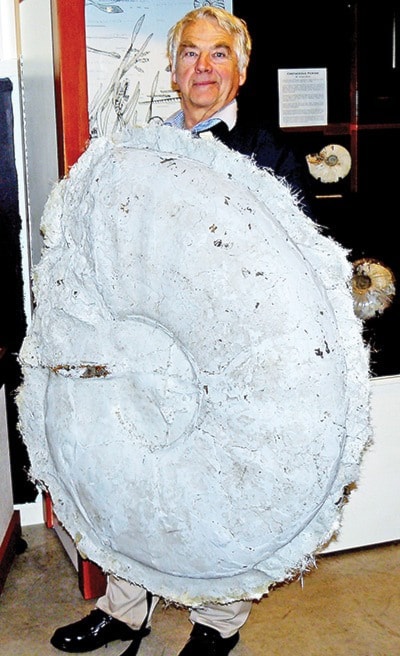In life, it crept along the bottom of the shallow sea, ambushing its prey — lobsters, crabs or even small dinosaurs — as nasty a piece of work as you’d find anywhere during the Upper Cretacious period.
Now, 70 million years later, Qualicum Beach paleontologist Graham Beard’s latest monster was found lurking on the floor of the woods by a Nanaimo family.
“It’s an ammonite, but I’m not sure of the species, except that it’s large,” Beard said. “It’s one of the largest I’ve seen from this area and the exciting thing is it’s from Nanaimo. They have a larger one in the Courtenay museum, but that one came from Fernie.”
The creature — or rather the impression it made in the mud — was discovered by Nanaimo residents Elke and Enzo Wohlleben as they went for a walk in the woods near their home.
“They were hiking in the woods and Elke walked over it and her son came up behind and he said, ‘didn’t you see this?’” Beard said. “They couldn’t believe it.”
The two got in touch with Beard and sent him a photograph of their find. Two weeks later, Beard and Rod Bartlet of the Geological Survey of Canada went on an expedition to the site, armed with everything they would need to make a cast of the beast.
“It was an octopus-like animal with a thick shell that probably had tentacles,” Beard said. “We know they had a beak like the modern octopus and a jaw that’s also quite similar. It was benthic, which means it probably crawled along the seabed, hunting for lobsters and crustaceans and even fish.”
An apex predator, the giant ammonite wouldn’t have turned its snout up at a small dinosaur or even, had he been able to transport himself there, a human of Beard’s size.
“Very few animals, even some of the marine reptiles that lived at that time, could have tackled an animal of that size,” Beard said. “We don’t know for sure, but it could have had a poisonous bite to protect itself. It would have had very few enemies.”
All that was left of the ammonite was the cast of its shell, but it’s one of the most complete specimens Beard has seen that even approaches this size.
Beard stressed the impression remains where it was found, but he was able to make a cast of it, first pouring a thin layer of wax into the impression, followed by a layer of fibreglass resin, followed by more resin and then fibreglass.
“It took a day and a half to make the cast,” Beard said.
Once it is trimmed and painted, the cast will be on display at the Qualicum Beach Museum.
